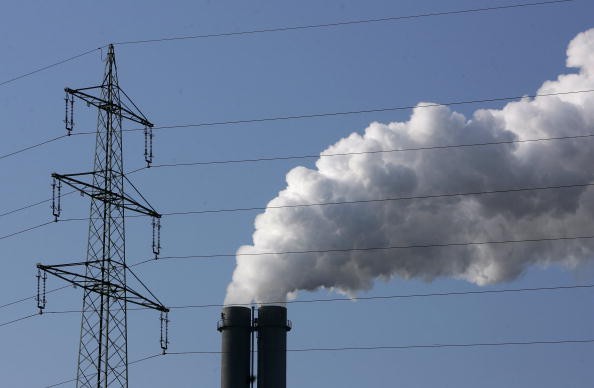NASA can't afford to continue its advanced greenhouse gas-detecting satellite.

(Photo : Photo by Sean Gallup/Getty Images)
An electricity pylon stands in front of the exhaust pluming from the main chimneys of the black coal-fired power plant Heizkraftwerk Reuter West March 23, 2007 in Berlin, Germany. Germany is still heavily dependant on coal for much of its electric power production, though is pushing an aggressive policy of CO2 emissions reductions.
Because of this, the international aerospace agency decided to cancel the technology.
On Tuesday, Nov. 29, the National Aeronautics and Space Administration announced that its greenhouse gas-detecting satellite, GeoCarb, was supposed to be a low-cost sat model.
However, it seems like the satellite is not really cheap as NASA faced cost overruns.
NASA Can't Afford Greenhouse Gas-Detecting Satellite
According to PhysOrg's latest report, when NASA announced its GeoCarb mission, the space union said that its estimated costs will only reach $166 million.

(Photo : Photo by NASA/Newsmakers)
STS-79 astronauts enjoy this view of the Mir complex backdropped against the blackness of space over Earth's horizon. A thin blue line of airglow runs parallel with Earth's horizon, September 24, 1996. Mir is nearing the end of its existence as Russia plans to steer the craft out of orbit in late February 2001 in a controlled crash to dump the space station safely into the Pacific Ocean.
However, NASA updated this estimation, saying that the greenhouse gas-detecting satellite's costs could be over $600 million.
"Decisions like this are difficult, but NASA is dedicated to making careful choices with the resources provided by the people of the United States," said NASA Science Associate Administrator Thomas Zurbuchen via the agency's official press release.
He added that they will make drastic efforts to accomplish their commitment to state-of-the-art climate observation.
Zurbuchen further stated that they will do this in a more efficient and cost-effective way.
What NASA Plans Next
NASA said that since it will no longer continue the GeoCarb mission, it will expand its efforts to find other efficient methods to observe greenhouse emissions.
One of these is the newest instrument, which was launched by NASA in July. The EMIT (Earth Surface Mineral Dust Source Investigation) is currently at the International Space Station.
This advanced technology can measure methane gases.
Aside from this, NASA will also launch a new Earth-focused mission, which is expected to be less risky and larger than the canceled GeoCarb mission.
You can visit this link to learn more about NASA's efforts to observe the rising greenhouse gases.
NASA is also quite busy with other technologies and other space missions.
Recently, the NASA Loftid heat shield for Mars was launched.
the NASA Artemis 1 Orion was able to enter a retrograde from the moon.
For more news updates about NASA and its upcoming innovations, always keep your tabs open here at TechTimes.
Related Article: NASA's Space-Based Water Recycling Techs Coming Back to Earth, But Why?






